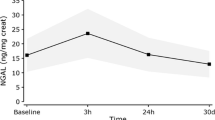Abstract
We tested the hypotheses that chronic human urinary obstruction impairs the renal regulation of the red blood cell (RBC) production and compared the chronic outcome of relief of obstruction between parenchyma-saving surgery and extracorporeal lithotripsy (SWL). We measured RBC count and serum erythropoietin (Epo) concentration before and 3 months after relief of urinary obstruction in 60 patients treated with pyelolithotomy, ureterolithotomy or ureteroscopy and in 62 patients treated with SWL. Compared with 333 healthy controls, at baseline, patients scheduled for parenchyma-saving surgery had lowered RBC count [9.9% (6.9–13.1); 95% confidence interval] in case of males and 17.7% (14.2–21.4) in case of females; minor depression in RBC count was also observed in female patients scheduled for SWL. Epo serum levels were mildly reduced in SWL patients and halved in parenchyma-saving surgery group. At 3 months following relief of obstruction in 50 operated patients without recurrent or residual stone, Epo levels almost doubled, becoming normal, while RBC count and haemoglobin concentration increased for 6.1% (3.8–8.8) and 8.8% (6.1–10.6). In contrast, in 49 SWL patients only minor, bidirectional responses to treatment were observed. We conclude that obstructive uropathy is associated with clinically relevant effects on erythropoiesis, which is reversed after relief of obstruction by parenchyma-saving surgery that saves the renal parenchyma.
Similar content being viewed by others
References
Bomanji J, Boddy SA, Britton KE, Nimmon CC, Whitfield HN (1987) Radionuclide evaluation pre- and postextracorporeal shock wave lithotripsy for renal calculi. J Nucl Med 28:1284–1289
Gupta M, Bolton DM, Irby P III, Hubner W, Wolf JS Jr, Hattner RS, Stoller ML (1995) The effect of newer generation lithotripsy upon renal function assessed by nuclear scintigraphy. J Urol 154:947–950
Eterovic D, Juretic-Kuscic Lj, Capkun V, Dujic Z (1999) Pyelolithotomy improves while extracorporeal lithotripsy impairs kidney function. J Urol 161:39–44
Eterovic D, Situm M, Juretic-Kuscic Lj, Dujic Z (2005) A decrease in blood pressure following pyelolithotomy but not extracorporeal lithotripsy. Urol Res 33:93–98
Jelkmann W (2004) Molecular biology of erythropoietin. Intern Med 43:649–659
Santoro A (2002) Anemia in renal insufficiency. Rev Clin Exp Hematol 1:12–20
Eschbach JW (1989) The anemia of chronic renal failure: pathophysiology and the effects of recombinant erythropoietin. Kidney Int 35:134–148
Chandra M, Clemons GK, McVicar MI (1988) Relation of serum erythropoietin levels to renal excretory function: evidence for lowered set point for erythropoietin production in chronic renal failure. J Pediatr 113:1015–1021
McGonigle RJ, Wallin JD, Shadduck RK, Fisher JW (1984) Erythropoietin deficiency and inhibition of erythropoiesis in renal insufficiency. Kidney Int 25:437–444
Radtke HW, Claussner A, Erbes PM, Scheuermann EH, Schoeppe W, Koch KM (1979) Serum erythropoietin concentration in chronic renal failure: relationship to degree of anemia and excretory renal function. Blood 54:877–884
Jelkmann W, Marienhoff N, Giesselmann S, Busch L (1988) Lowered plasma erythropoietin in hypoxic rats with kidney tubule lesions. Blut 57:317–321
Maxwell PH, Ferguson DJ, Nicholls LG, Johnson MH, Ratcliffe PJ (1997) The interstitial response to renal injury: fibroblast-like cells show phenotypic changes and have reduced potential for erythropoietin gene expression. Kidney Int 52:715–724
Maxwell PH, Ferguson DJ, Nicholls LG, Iredale JP, Pugh CW, Johnson MH, Ratcliffe PJ (1997) Sites of erythropoietin production. Kidney Int 51:393–401
Tan CC, Eckardt KU, Ratcliffe PJ (1991) Organ distribution of erythropoietin messenger RNA in normal and uremic rats. Kidney Int 40:69–76
Tan CC, Tan LH, Eckardt KU (1996) Erythropoietin production in rats with post-ischemic acute renal failure. Kidney Int 50:1958–1964
Priyadarshi A, Periyasamy S, Burka TJ, Britton SL, Malhotra D, Shapiro JI (2002) Effects of reduction of renal mass on renal oxygen tension and erythropoietin production in the rat. Kidney Int 61:542–546
Necas E, Ponka P (1998) Ureter obliteration transiently depresses erythropoietin production. Eur J Clin Invest 28:918–923
Tsukada Y, Murata N, Yano S, Naruse T (1994) Transient suppression of erythropoietin synthesis in hydronephrosis. Nephron 68:282–283
Fisher JW (2003) Erythropoietin: physiology and pharmacology update. Exp Biol Med 28:1–14
Kendall RG (2001) Erythropoietin. Clin Lab Haematol 23:71–80
Eckardt KU, Kurtz A, Bauer C (1989) Regulation of erythropoietin production is related to proximal tubular function. Am J Physiol 256:F942–F947
Campbell MF, Walsh CW, Retik AB (eds) (2002) Campbell’s urology, 8th edn. Saunders Company, Philadelphia, pp 342–385
Freudenthaler SM, Lucht I, Schenk T, Brink M, Gleiter CH (2000) Dose-dependent effect of angiotensin II on human erythropoietin production. Pflugers Arch 439:838–844
Acknowledgments
This research was partially funded by the grant 216-0000-0216 the Croatian Ministry of Science, Technology and Sports.
Author information
Authors and Affiliations
Corresponding author
Rights and permissions
About this article
Cite this article
Eterović, D., Šitum, M., Punda, A. et al. Urinary obstruction depresses erythropoiesis which recovers after parenchyma-saving surgery but not SWL. Urol Res 38, 51–56 (2010). https://doi.org/10.1007/s00240-009-0234-0
Received:
Accepted:
Published:
Issue Date:
DOI: https://doi.org/10.1007/s00240-009-0234-0




